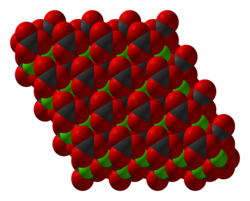Mn2+[CO32−] | |
 | |
| Names | |
|---|---|
| IUPAC name Manganese(II) carbonate | |
| Identifiers | |
3D model (JSmol) | |
| ChemSpider | |
| ECHA InfoCard | 100.009.040 |
| EC Number |
|
PubChem CID | |
| UNII | |
CompTox Dashboard (EPA) | |
| |
| |
| Properties | |
| MnCO3 | |
| Molar mass | 114.95 g mol−1 |
| Appearance | White to very faint pink solid |
| Density | 3.12 g/cm3 |
| Melting point | 200–300 °C (392–572 °F; 473–573 K) decomposes [1] [2] |
| negligible | |
Solubility product (Ksp) | 2.24 x 10−11 |
| Solubility | soluble in dilute acid, CO2 insoluble in alcohol, ammonia |
| +11,400·10−6 cm3/mol | |
Refractive index (nD) | 1.597 (20 °C, 589 nm) |
| Structure | |
| hexagonal-rhombohedral | |
| Thermochemistry | |
Heat capacity (C) | 94.8 J/mol·K [2] |
Std molar entropy (S⦵298) | 109.5 J/mol·K [2] |
Std enthalpy of formation (ΔfH⦵298) | −881.7 kJ/mol [2] |
Gibbs free energy (ΔfG⦵) | −811.4 kJ/mol [2] |
| Hazards | |
| Flash point | Non-flammable |
Except where otherwise noted, data are given for materials in their standard state (at 25 °C [77 °F], 100 kPa). | |
Manganese carbonate is a compound with the chemical formula Mn CO3. Manganese carbonate occurs naturally as the mineral rhodochrosite but it is typically produced industrially. It is a pale pink, water-insoluble salt. Approximately 20,000 metric tonnes were produced in 2005. [3]

